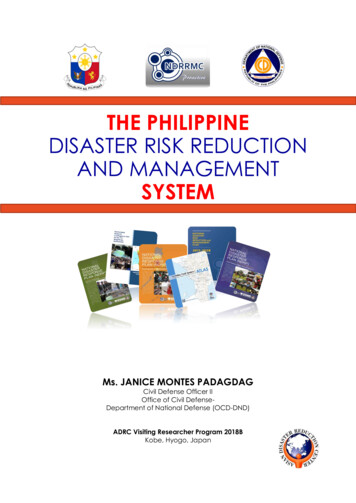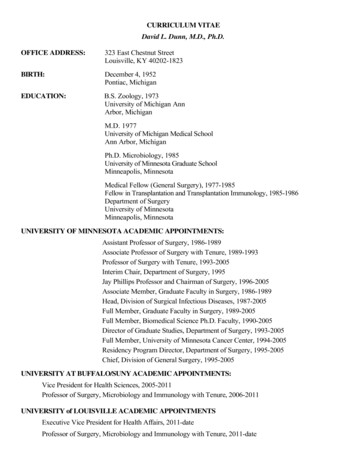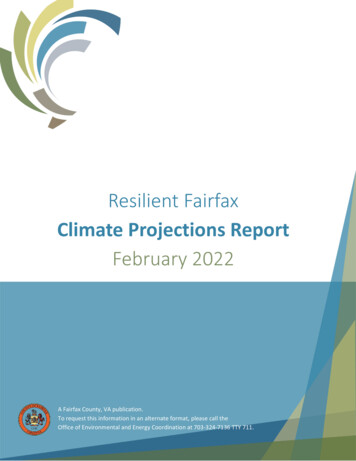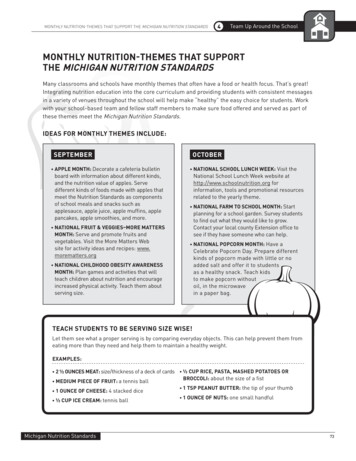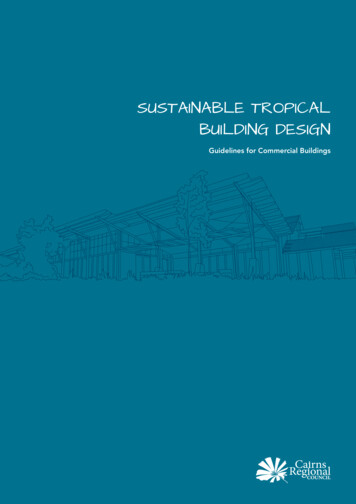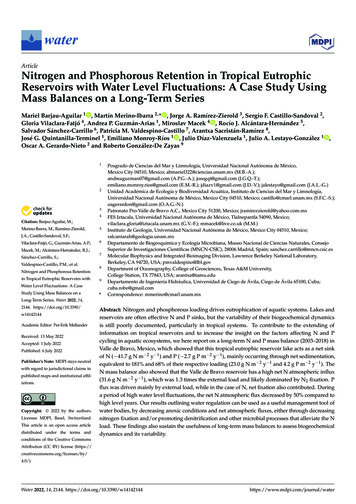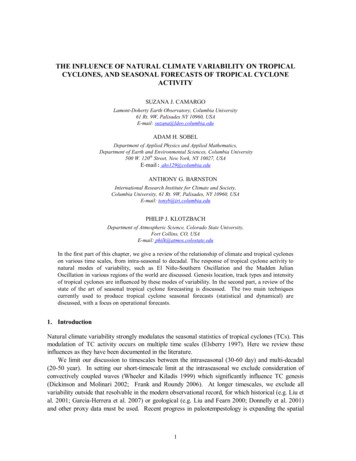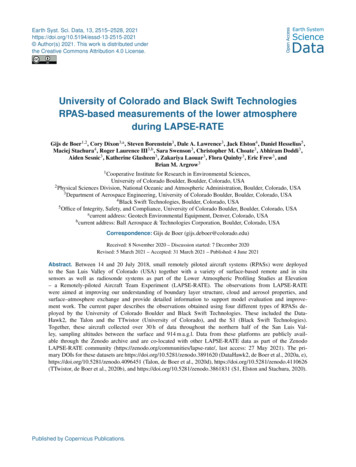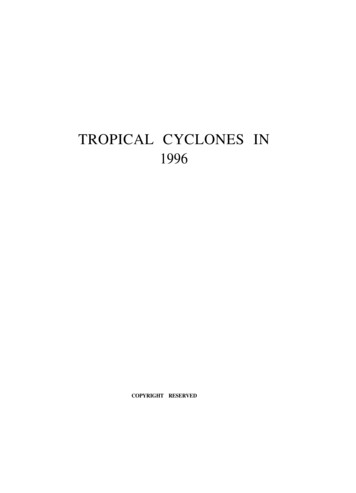
Transcription
TROPICAL CYCLONES IN1996COPYRIGHT RESERVED
PublishedMarch 1997July 1997DistributedHong Kong Observatory134A Nathan RoadKowloonHong KongThis publication is prepared and disseminated in the interest of promoting the exchange of information. TheGovernment of Hong Kong (including its servants and agents) makes no warranty, statement or representation,express or implied, with respect to the accuracy, completeness, or usefulness of the information contained herein,and in so far as permitted by law, shall not have any legal liability or responsibility (including liability fornegligence) for any loss, damage or injury (including death) which may result, whether directly or indirectly, fromthe supply or use of such information.Permission to reproduce any part of this publication should be obtained through the Observatory.This publication is available from:Government Publications CentreGround FloorQueensway Government Offices66 QueenswayHong Kong551.515.2:551.506.1(512.317)
3CONTENTSPageFRONTISPIECE : Tracks of tropical cyclones in the western North Pacific and the South China Seain 1996FIGURES4TABLES6HONG KONG'S TROPICAL CYCLONE WARNING SIGNALS71.INTRODUCTION92.TROPICAL CYCLONE OVERVIEW FOR 1996133.REPORTS ON TROPICAL CYCLONES AFFECTING HONG KONG IN 199621(a) Severe Tropical Storm Frankie (9607) : 21 - 24 July22(b) Typhoon Gloria (9608) : 21 - 27 July26(c) Tropical Depression Lisa (9611) : 6 - 7 August30(d) Typhoon Niki (9613) : 18 - 23 August34(e) Typhoon Sally (9616) : 5 - 10 September38(f) Severe Tropical Storm Willie (9619) : 18 - 23 September45(g) Typhoon Beth (9622) : 15 - 21 October494.TROPICAL CYCLONE STATISTICS AND TABLES535.TROPICAL CYCLONE POSITION AND INTENSITY DATA, 199669
4FIGURESPage1. Locations of anemometers and tide gauge stations mentioned in this report122. Monthly distribution of the frequency of first occurrence of tropical cyclones in the westernNorth Pacific and the South China Sea in 1996153. Monthly distribution of the mean frequency of first occurrence of tropical cyclones in thewestern North Pacific and the South China Sea, 1961-1990154. Track of Severe Tropical Storm Frankie (9607) : 21 - 24 July 1996245. Rainfall distribution on 21 - 23 July 1996246. Visible imagery of Frankie at around 11 a.m. on 22 July 1996 (originally captured byGMS of JMA)257. Visible imagery of Frankie at around 11 a.m. on 23 July 1996 (originally captured byGMS of JMA)258. Track of Typhoon Gloria (9608) : 21 - 27 July 1996289. Rainfall distribution on 26 - 30 July 19962810. Visible imagery of Gloria at around 11 a.m. on 26 July 1996 (originally captured byGMS of JMA)2911. Visible imagery of Gloria at around 11 a.m. on 27 July 1996 (originally captured byGMS of JMA)2912. Track of Tropical Depression Lisa (9611) : 6 - 7 August 19963213. Rainfall distribution on 6 - 7 August 19963214. Infra-red imagery of Lisa at around 5 p.m. on 6 August 1996 (originally captured byGMS of JMA)3315. Visible imagery of Lisa at around 8 a.m. on 7 August 1996 (originally captured byGMS of JMA)3316. Track of Typhoon Niki (9613) :18 - 23 August 19963617. Rainfall distribution on 20 - 22 August 19963618. Infra-red imagery of Niki at around 8 p.m. on 20 August 1996 (originally captured byGMS of JMA)3719. Visible imagery of Niki at around 2 p.m. on 21 August 1996 (originally captured byGMS of JMA)37
5FIGURESPage20.Track of Typhoon Sally (9616) : 5 - 10 September 19964121.Rainfall distribution on 8 - 10 September 19964122.Visible imagery of Sally at around 11 a.m. on 8 September 1996 (originally capturedby GMS of JMA)42Infra-red imagery of Sally at around 7 p.m. on 8 September 1996 (originally capturedby GMS of JMA)4223.24. Radar display of the rain echoes of Sally at 2.00 a.m. on 9 September 19964325.A scaffolding collapsed onto the roof of a factory in Wong Chuk Hang4326.A railing blown down from the roof top of a high rise building in Ma On Shan4427.Track of Severe Tropical Storm Willie (9619) : 18 - 23 September 19964728.Rainfall distribution on 18 - 22 September 19964729.Visible imagery of Willie at around 11 a.m. on 19 September 1996 (originallycaptured by GMS of JMA)48Infra-red imagery of Willie at around 2 a.m. on 20 September 1996 (originallycaptured by GMS of JMA)48Track of Typhoon Beth (9622) : 15 - 21 October 19965130.31.32. Rainfall distribution on 19 - 21 October 199633.34.51Visible imagery of Beth at around 11 a.m. on 19 October 1996 (originally capturedby GMS of JMA)52Visible imagery of Beth at around 11 a.m. on 20 October 1996 (originally capturedby GMS of JMA)52
6TABLESPage1.List of tropical cyclones in the western North Pacific and the South China Sea in 1996552.Tropical cyclone warnings for shipping issued in 1996563.Tropical cyclone warning signals hoisted in Hong Kong and number of warning bulletinsissued in 1996574.Frequency and total duration of display of tropical cyclone warning signals: 1956-1996585.Number of tropical cyclones in Hong Kong's area of responsibility and the number thatnecessitated the display of tropical cyclone warning signals in Hong Kong: 1956-1996596.Duration of tropical cyclone warning signals hoisted in Hong Kong: 1956-1996607.A summary of meteorological observations recorded in Hong Kong during the passagesof tropical cyclones in 1996618.Tropical cyclone rainfall in Hong Kong639.Typhoons requiring the hoisting of the Hurricane Signal No. 10 during the period 194619966510. Casualties and damage caused by tropical cyclones in Hong Kong: 1967-199666
7Hong Kong's Tropical Cyclone Warning Signals
Section 1INTRODUCTION
10Apart from a short break during 1940-1946, surface observations of meteorological elements since 1884 have beensummarized and published in the Observatory's Meteorological Results. Upper-air observations began in 1947 andfrom then onwards the annual publication was divided into two parts, namely Part I - Surface Observations and Part II- Upper-air Observations. These two publications were re-titled "Summary of Radiosonde-Radiowind Ascents" and"Surface Observations in Hong Kong" in 1981 and 1987 respectively. In 1993, both of these publications were madeobsolete, and since then surface and upper-air data have been included in one revised publication entitled "Summaryof Meteorological Observations in Hong Kong".During the period 1884-1939, reports on some destructive typhoons were printed as Appendices to theMeteorological Results. This practice was extended and accounts of all tropical cyclones which caused gales in HongKong were included in the Director's Annual Departmental Reports from 1947 to 1967 inclusive. The series"Meteorological Results Part III - Tropical Cyclone Summaries" was subsequently introduced. It containedinformation on tropical cyclones over the western North Pacific and the South China Sea. The first issue, whichcontained reports on tropical cyclones occurring in 1968, was published in 1971. Tropical cyclones within the areabounded by the Equator, 45oN, 100oE and 160oE were described. With reconnaissance aircraft reports (terminatedfrom August 1987 onwards) and satellite pictures facilitating the tracking of tropical cyclones over the otherwise datasparse ocean, the eastern boundary of the area of coverage was extended from 160oE to 180o from 1985 onwards.Starting from 1987, the series was re-titled as "Tropical Cyclones in 19YY" but its contents remained largely thesame.Tracks of tropical cyclones in the western North Pacific and the South China Sea were published in MeteorologicalResults up to 1939 and in Meteorological Results Part I from 1947 to 1967. Before 1961, only daily positions wereplotted on the tracks. The time of the daily positions varied to some extent in the older publications but remainedfixed at 0000 UTC after 1944. Details of the variation are given in the Royal Observatory Technical Memoir No. 11,Volume 1. From 1961 onwards, six-hourly positions are shown on the tracks of all tropical cyclones.Provisional reports on individual tropical cyclones affecting Hong Kong have been prepared since 1960 to meet theimmediate needs of the press, shipping companies and others. These reports are printed and supplied on request.Initially, reports were only written on those tropical cyclones for which gale or storm signals had been hoisted inHong Kong. By 1968, it had become necessary to produce a report on every tropical cyclone that necessitated thehoisting of tropical cyclone warning signals.In this publication, tropical cyclones are classified into the following four categories according to the maximumsustained surface winds near their centres :A TROPICAL DEPRESSION (T.D.) has maximum sustained winds of less than 63 km/h.A TROPICAL STORM (T.S.) has maximum sustained winds in the range 63-87 km/h.A SEVERE TROPICAL STORM (S.T.S.) has maximum sustained winds in the range 88-117 km/h.A TYPHOON (T.) has maximum sustained winds of 118 km/h or more.Throughout this publication, maximum sustained surface winds when used without qualification refer to windspeeds averaged over a period of 10 minutes. Mean hourly winds are winds averaged over a 60-minute intervalending on the hour. Daily rainfall amounts are computed over a 24-hour period ending at midnight Hong KongTime.Over the western North Pacific and the South China Sea, tropical cyclone names are assigned by the Joint TyphoonWarning Center in Guam according to a pre-determined list that undergoes revisions from time to time. Since 1981,a common system for identification of tropical cyclones in the western North Pacific and the South China Sea hasbeen adopted and the Japan Meteorological Agency is delegated with the responsibility of assigning to each tropicalcyclone of tropical storm intensity or above a numerical code of four digits. For example, the second tropicalcyclone of tropical storm intensity or above as classified by Japan Meteorological Agency which occurred withinthe region in 1996 was assigned the code "9602". In this publication, the appropriate code immediately follows thename of the tropical cyclone in bracket, e.g. Tropical Storm Ann (9602).Surface wind data presented in this report were obtained from a network of anemometers operated by theObservatory. Details of the stations are listed on the next page:
11Maximum storm surges caused by tropical cyclones were measured by tide gauges installed at several locationsaround Hong Kong. The locations of anemometers and tide gauges mentioned in this report are shown in Figure 1.In Section 2, an overall review of all the tropical cyclones over the western North Pacific and the South China Seain 1996 is presented.The reports in Section 3 are individual accounts of the life history of tropical cyclones affecting Hong Kong in 1996.They include the following information:(a) the effects of the tropical cyclone on Hong Kong;(b) the sequence of display of tropical cyclone warning signals;(c) the maximum gust peak speeds and maximum hourly mean winds recorded in Hong Kong;(d) the lowest barometric pressure recorded at the Observatory;(e) the daily amounts of rainfall recorded at the Observatory and selected locations;(f) the times and heights of the highest tides and maximum storm surges recorded in Hong Kong;(g) satellite pictures and/or radar displays if applicable.Statistics and information relating to tropical cyclones are presented in various tables in Section 4.Six-hourly positions together with the corresponding estimated minimum central pressures and maximum sustainedsurface winds for individual tropical cyclones are tabulated in Section 5.In this publication, different times are used in different contexts. The official reference times are given in Coordinated Universal Time and labelled UTC. Times of the day expressed as "a.m." or "p.m." or as "morning","evening', etc. in the tropical cyclone narratives are in Hong Kong Time which is eight hours ahead of UTC.
12
Section 2TROPICAL CYCLONE OVERVIEWFOR 1996
14In 1996, there were 32 tropical cyclones over the western North Pacific and the adjacent seas bounded by theequator, 45 o N, 100 o E and 180 o . Compared with the 30-year annual average (1961-1990) of 31 tropicalcyclones, 1996 was a year with near normal tropical cyclone activity. Also, the number of tropical cyclonesattaining typhoon intensity was near normal - a total of 16 typhoons in 1996 against the 30-year annualaverage of 15.6. The monthly distributions of the frequency of first occurrence of tropical cyclones and thatof typhoons for 1996 are shown in Figure 2. The monthly mean frequencies of these two parameters duringthe years 1961 - 1990 are shown in Figure 3.Amongst the tropical cyclones that affected the coast of Guangdong in 1996, Typhoon Sally (9616) wouldhave been one of the most unforgettable in terms of its exceptionally fast movement over the South China Seaand the heavy death toll it brought on in western Guangdong and Guangxi. Substantial damage was alsoinflicted on Hainan Island by three tropical cyclones namely Frankie (9607), Niki (9613) and Willie (9619).Two typhoons, Gloria (9608) and Herb (9609), ravaged Taiwan in July and August respectively, and theyalso moved on to hit Fujian after crossing the Taiwan Strait. These two typhoons together with TropicalDepression Lisa (9611) were the only tropical cyclones that affected the east coast of China during the year.During the year, 15 tropical cyclones occurred within the area of responsibility of Hong Kong (i.e. the areabounded by 10o N, 30 o N, 105 o E and 125o E). This number was near the 30-year (1961-90) annual average of16.4. Of the 15 tropical cyclones, six developed within Hong Kong's area of responsibility. Altogether, 360tropical cyclone warnings to ships and vessels were issued by the Observatory in 1996 (Table 2).Local warning signals were hoisted in Hong Kong for seven tropical cyclones. Apart from Sally (9616) forwhich the highest signal hoisted was No. 8, all other tropical cyclones that affected Hong Kong, namelyFrankie (9607), Gloria (9608) Lisa (9611), Niki (9613), Willie (9619) and Beth (9622), necessitated only thedisplay of the Stand By Signal No. 1.The total tropical cyclone rainfall (defined as the total rainfall recorded at the Observatory from the timewhen a tropical cyclone was centred within 600 km of Hong Kong to 72 hours after the tropical cyclone hasdissipated or moved outside 600 km of Hong Kong) in 1996 amounted to 430.9 mm, 42 per cent belowthe mean annual value of 741.0 mm (1961-1990). It accounted for 19 per cent of the year's total rainfall of2 249.1 mm. Rainfall figures associated with those tropical cyclones coming within 600 km of Hong Kong,altogether ten, are given in Table 8(a).A review of all the tropical cyclones in 1996 is given in the following paragraphs.The first tropical cyclone of 1996 was a tropical depression (9601) forming over the waters off the eastcoast of the Philippines about 1 150 km southeast of Manila on 28 February. Tracking west-northwestwards,this tropical depression crossed the Philippines and then dissipated over water on the night of 1 March.In April, Ann (9602) formed as a tropical depression over the Pacific about 340 km west-northwest of Yapon 5 April and intensified into a tropical storm early the next morning. Moving westwards, it landed over thePhilippines on 7 April. Ann weakened gradually and dissipated over the islands the next day.Two tropical cyclones occurred over the western North Pacific and the South China Sea in May.Over the western North Pacific, Bart (9603) developed as a tropical depression about 130 km west of Yapon 10 May. Tracking northwestwards, it intensified gradually and attained typhoon strength on 13 May. Bartrecurved towards the northeast two days later and started to weaken. It became extratropical on 18 May.Over the South China Sea, Cam (9604) formed as a tropical depression about 130 km east-southeast ofXisha on the night of 19 May and deepened into a tropical storm the next day. Heading northeastwards
15
16towards the Luzon Strait, Cam passed about 190 km to the south of Dongsha and was distant enough to spareHong Kong from its influence. Cam entered the Pacific on 23 May and dissipated the next day.Seven tropical cyclones occurred over the western North Pacific and the South China Sea in July. Amongstthem, Severe Tropical Storm Frankie (9607) and Typhoon Gloria (9608) necessitated the hoisting of the StandBy Signal No. 1 in Hong Kong.The first tropical cyclone in July formed about 950 km southeast of Iwo Jima on 5 July and was namedDan (9605). Tracking northwestwards, Dan intensified gradually and attained typhoon strength three dayslater. It then turned northwards towards Japan and weakened gradually. Passing about 250 km southeast ofTokyo, Dan took on a northeastward track and became extratropical on 11 July.Typhoon Eve (9606) developed as a tropical depression about 640 km13 July. Moving steadily northwestwards, it attained typhoon intensity on 15northwestward track towards Japan and made landfall over Kyushu on 18traversing northwards over Kyushu, dissipating into an area of low pressure15 people were injured during the passage of Eve.south-southeast of Iwo Jima onJuly. Eve continued on a northJuly. It weakened rapidly whilethe next day. In Japan, at leastOver the South China Sea, Frankie formed as a tropical depression about 170 km east-southeast of Xishaon 21 July. It intensified into a tropical storm and traversed Hainan Island the next day. Frankie crossedBeibu Wan and landed over northern Vietnam on 24 July, dissipating over land.While Frankie was developing over the South China Sea, another tropical depression named Gloria formedover the western North Pacific about 1 340 km east-southeast of Manila on 21 July. Skirting past Luzon andthe southern tip of Taiwan, Gloria finally made landfall near Xiamen on 27 July and dissipated over land.Detailed reports on Frankie and Gloria are presented in Section 3.Herb (9609) developed as a tropical depression over the Pacific about 1 070 km east-northeast of Guam on23 July. Tracking westwards, it intensified over water and attained typhoon intensity on 26 July. Herbadopted a northwestward track on 29 July and traversed the northern part of Taiwan on the early morning of1 August, inflicting heavy damage on the island. At least 40 people were killed, 34 reported missing and 380injured. Apart from bringing serious flooding and landslides, Herb also disrupted electricity supply to overtwo million households. A total of 13 counties were declared major disaster areas in the wake of Herb. Theeconomic loss in Taiwan was put at NT 30 billion. After crossing the Taiwan Strait, Herb made landfallover Fujian on 1 August causing severe damage where 18 people were killed and 2 300 houses were destroyedor inundated. The high winds associated with Herb also affected the coast of Zhejiang where five people werekilled and five others were reported missing. Herb finally dissipated as an area of low pressure as it movedfurther inland.Ian developed as a tropical depression about 200 km northwest of Guam on the early morning of 29 July. Ittracked northwestwards and dissipated over water on 30 July.The last tropical cyclone in July was Joy (9610). It formed as a tropical depression about 1 220 km east ofIwo Jima on 30 July. Drifting slowly at first, it began to move north-northwestwards on 1 August andintensified into a severe tropical storm. Joy turned eastwards the next day, but resumed a northnorthwestward course on 4 August. It dissipated over water on 5 August.Eight tropical cyclones formed over the western North Pacific and the South China Sea in August.Amongst them, Tropical Depression Lisa (9611) and Typhoon Niki (9613) necessitated the hoisting of theStand By Signal No. 1 in Hong Kong.
17Kirk (9612) developed as a tropical depression about 570 km east of Okinawa on 4 August. It movednorthwestwards at first, but adopted a southeastward track on 6 August while intensifying east of Okinawa.Having attained typhoon strength, Kirk tracked towards the Ryukyus and traversed the islands on 12 August.It then moved on to ravage Kyushu and Honshu on 14 and 15 August, killing seven people and injuring about60. Kirk became extratropical on 15 August.Over the South China Sea, Lisa formed as a tropical depression about 170 km west-northwest of Dongshaon the morning of 6 August. Moving northeastwards, it made landfall near Shantou that evening anddissipated over land the next morning. A detailed report on Lisa is presented in Section 3.A tropical depression developed over the Pacific about 1 710 km north-northwest of Wake Island on12 August. Moving southeastwards at first, it turned northeastwards on 14 August and dissipated over waterthe next day.Another short-lived tropical depression named Marty formed over Beibu Wan about 130 km east of Hanoion the night of 13 August. Tracking southwestwards, it made landfall over northern Vietnam the next day anddissipated over land on the early morning of 15 August.Niki developed as a tropical depression about 970 km east-northeast of Manila on 18 August. Aftersweeping across Luzon, it entered the South China Sea on 20 August and rampaged through Hainan Islandtwo days later. Niki made landfall over northern Vietnam on the morning of 23 August and dissipated. Adetailed report on Niki is presented in Section 3.While Niki was wreaking havoc on Hainan, a tropical depression named Orson (9614) formed about340 km south-southeast of Iwo Jima on 22 August. Orson drifted slowly at first but began to move eastnortheastwards on 24 August and attained typhoon intensity the next day. After completing a clockwise loopon 27 and 28 August, Orson adopted a northwestward track and weakened. It intensified again on 31 Augustand began to recurve northeastwards the next day. Orson became extratropical on 3 September.Over the western North Pacific, Piper (96 15) developed as a tropical depression about 1 190 km northwestof Wake Island on 23 August. It moved on a northward course and intensified into a severe tropical storm on24 August. Piper became extratropical on 26 August.Tropical Depression Rick formed about 1 360 km north-northeast of Wake Island on 30 August. It trackednorthwestwards at first and turned east-northeastwards the next day. Rick dissipated on 1 September.A total of six tropical cyclones formed over the western North Pacific and the South China Sea inSeptember. Typhoon Sally (9616) necessitated the hoisting of the Strong Wind Signal No.3 and the Gale orStorm Signal No. 8 in Hong Kong for the first time in 1996. The Stand By Signal No. 1 was alsodisplayed for Severe Tropical Storm Willie (9619).Typhoon Sally developed as a tropical depression about 1 300 km east of Manila on 5 September. Itentered the South China Sea on 8 September and later traversed Leizhou and Guangxi. Sally dissipated overnorthern Vietnam on 10 September. A detailed report on Sally is presented in Section 3.Typhoon Violet (9617) developed over the western North Pacific about 1 030 km east of Manila on12 September. Heading northwestwards, it intensified rapidly and attained typhoon strength on 14 September.Violet recurved northeastwards on 16 September and skirted past the southeastern coast of Japan on22 September. It became extratropical the next day. Violet caused flooding and landslides in Japan, leavingat least eight people dead, five missing and 43 injured.
18Soon after the formation of Violet, Tom (9618) developed as a tropical depression about 510 km eastnortheast of Guam on 12 September. It moved northwestwards at first and intensified into a typhoon fourdays later. Tracking northeastwards, Tom became extratropical on 19 September.Willie developed as a tropical depression about 200 km west-northwest of Xisha on 18 September. Itmoved northeastwards at first but turned northwestwards the next day. Willie adopted a west-southwestwardtrack on 20 September and skirted past Leizhou and Hainan. It eventually made landfall over Vietnam on22 September and dissipated over land. A detailed report on Willie is presented in Section 3.Yates (9620) formed as a tropical depression about 1 360 km east of Guam on 23 September. It intensifiedinto a typhoon the next day while tracking westwards. Yates took on a northwestward course on26 September and started recurving three days later. It became extratropical on 1 October while movingnortheastwards over the Pacific.A tropical depression named Zane (9621) developed about 830 km west-northwest of Guam on24 September. Tracking west-northwestwards, it attained typhoon intensity on 26 September. Zane took on anorthward track two days later over the waters off the east coast of Taiwan and turned east-northeastwards on30 September when it was over the Ryukyu Islands. Zane became extratropical on 3 October. In northernTaiwan, torrential rain associated with Typhoon Zane set off mudslides and cut roads. At least four personswere killed and about 420 people were stranded by floods. In Okinawa, electricity failure affected 7 730households.In October, Typhoon Beth (9622) necessitated the hoisting of the Stand By Signal No. 1 in Hong Kong.Beth developed as a tropical depression about 930 km east-northeast of Manila on 15 October. Trackingwestwards, it attained typhoon intensity on 17 October and entered the South China Sea the next day. Bethdissipated over water near Xisha on 21 October. A detailed report on Beth is presented in Section 3.Typhoon Carlo (9623) formed as a tropical depression about 730 km northeast of Guam on 21 October. Itgathered strength over water and attained typhoon intensity on 24 October while moving northwards. Carloadopted a northeastward track on 25 October after passing about 350 km east of Iwo Jima. It dissipated overwater the next day.Three tropical cyclones formed over the western North Pacific and the South China Sea in November.A tropical depression developed over the South China Sea about 250 km north of Nansha on 2 November.Moving on a northwestward track, this tropical depression made landfall over Vietnam the next day anddissipated over land.Dale (9624) formed as a tropical depression about 890 km east-southeast of Guam on 4 November. Dalewas slow moving at first, but it started to move westwards two days later. Having intensified into a typhoon,Dale took on a northwestward track on 8 November and then recurved northeastwards on 12 November. Itbecame extratropical on 13 November.An area of disturbance developed into Tropical Depression Ernie (9625) about 780 km west-southwest ofYap on 4 November. It moved northwestwards at first, but turned westwards on 7 November while traversingthe central Philippines. Ernie took on a northward course over the South China Sea the next day, slowingdown when it was about 150 km southeast of Dongsha and then drifting southeastwards towards Luzon.Ernie turned towards the southwest along the west coast of Luzon on 12 November, thus completing a largeclockwise loop over the South China Sea. Ernie dissipated over the coastal waters of southern Vietnam on16 November. In the central Philippines 12 people were killed and 15 were missing in stormy weatherassociated with Ernie.
19Two tropical cyclones occurred over the western North Pacific and the South China Sea in December.Fern (9626) formed as a tropical depression about 370 km east of Yap on 22 December and soon deepenedinto a tropical storm. Moving westwards, Fern became a severe tropical storm and started tracking steadilynorthwards on 25 December. Fern turned northeastwards on 28 December and gradually weakened into anarea of low pressure two days later.Over the southern part of the South China Sea, a tropical depression named Greg developed about 390 kmsouth-southwest of Nansha on 25 December. Tracking eastwards, Greg rampaged through the state of Sabahin Malaysia on 26 December and then weakened quickly into an area of low pressure. Greg killed at least 140people in Sabah, leaving about 200 people missing and making over 3 000 homeless.Note: Casualties and damage figures were compiled from press reports.
Section 3REPORTS ON TROPICAL CYCLONESAFFECTING HONG KONG IN 1996
22(a) Severe Tropical Storm Frankie (9607)21 - 24 July 1996The track of Frankie is shown in Figure 4Over the South China Sea, Frankie formed as a tropical depression about 170 km east-southeast of Xisha onthe morning of 21 July. Moving northwestwards, it intensified into a tropical storm and traversed HainanIsland the next day. In Hainan a thousand-tonne vessel capsized in high winds resulting in one death and 17people missing. Moving across Beibu Wan and intensifying further into a severe tropical storm, Frankie madelandfall over northern Vietnam on 24 July and gradually dissipated over land. In Vietnam more than 40 peoplewere killed and 224 were injured.In Hong Kong the Stand By Signal No.1 was hoisted at 2.30 p.m. on 21 July when Frankie was about570 km to the south. Under the influence of its outer rainbands, there were occasional heavy squally showerswith fresh gusty winds from the east. As Frankie intensified and moved closer, local winds becameoccasionally strong offshore and on high ground. Frankie began moving away from Hong Kong on the eveningof 22 July and the No. 1 Signal was lowered at 10.30 p.m. Frankie was closest to Hong Kong at about 5 p.m.on 22 July when it was about 530 km to the southwest. At the Observatory Headquarters, the lowest hourlysea-level pressure of 1 001.9 hPa was recorded at 4 p.m.During the passage of Frankie, there were several reports of toppled trees due to gusty winds but no injurieswere reported.The rainfall distribution associated with Frankie is shown in Figure 5. Information on wind, rainfall and tideduring the passage of Frankie is given as follows :Maximum gust peak speeds and maximum hourly mean winds with associated wind directions recorded atvarious stations during the hoisting of tropical cyclone warning signal for Fran
GMS of JMA) 29 11. Visible imagery of Gloria at around 11 a.m. on 27 July 1996 (originally captured by GMS of JMA) 29 12. Track of Tropical Depression Lisa (9611) 6 - 7 August 1996: 32 13. Rainfall distribution on 6 - 7 August 1996 32 14. Infra-red imagery of Lisa at around 5 p.m. on 6 August 1996 (originally captured by GMS of JMA) 33 15.
